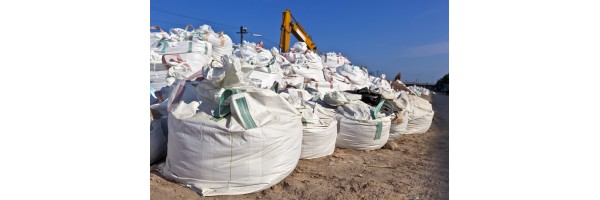
Here at Centurion Packaging, we are always striving to help all of our customers stay safe when using FIBCs in their workplaces.
This is why we have put together these handy safety guides regarding the use of bulk bags for cranes, forklifts and cranes.
Four Safety Tips for FIBC Bulk Bags
Firstly, make sure your equipment is rated for use with bulk bags. If the equipment is not rated for use with FIBCs this will put your employees in danger. Even if your equipment is not specifically designed for use with bulk bags, it will still need to be rated for use with them. Please contact your equipment dealer directly if you are unsure.
Ensure that safety latches exist and are being used. Your lifting equipment will come with safety latches or harnesses, so make sure they are being used.
Do not exceed your maximum rated weight of the bag. Exceeding the safe working load for FIBCs can lead to potential injuries or worse for your workers.
Make sure your equipment has no sharp edges. Rounded edges with a radius of 55mm at a minimum are preferred. Sharp edges will tear your bag during handling and create dangerous scenarios for your team.
Now we are going to look at the key points of FIBC safety for hoists, cranes and forklifts.
Safety When Using Hoists and Cranes
Never suspend a bulk bag with less than all loops that are provided in the bag and also remember not to gather loops to a lift with a single hook. Although there are exceptions, some bags are specifically designed to be lifted with a single loop.
When lifting with a single hook, a sling or another lifting device, keep the lift loops vertical which prevents damaging lateral forces. Under no circumstances allow a person to be underneath a suspended FIBC bag and ensure all personnel are clear of any safety hazards.
You will also need to address all electrostatic concerns before handling an FIBC and ensure any handling device being used for grounding the bag is clear of any substances or hazardous explosive materials.
FIBC Movement with Forklifts
Make sure you never suspend the bulk bag with less than all loops that are provided on the bag, as this can cause the bag to become unbalanced which could lead to the dumping of the bag's content.
Forklift tines need to be level so lift loops are kept vertical, which ensures the bag is not dragging or falling off the tines which prevent accidental discharge.
If you are using pallets, ensure they are free of nails and protrusions and properly sized. Keeping the FIBC close to the operator and not tilted forward reduces the chance of the bulk bag falling off the tines.
Keep the forklift operator's line of sight clear before moving the bag using a forklift and keep clear of the ground and forklift wheels.
Avoid fast starts and stops, which can cause the bag to move on the forklift tines which could dislodge the bag and create a serious safety hazard.
Do not push a bulk bag or drag on the ground and stop any forklift motion before lowering or raising the bulk bag.
Get in Touch for More Information
If you want to know more information about Centurion Packaging’s range of bulk bags, please contact us today.
Centurion Packaging is one of the country's leading suppliers of woven polypropylene and polythene products.

 5% OFF YOUR FIRST ORDER OVER £50! JUST USE COUPON “MY1STORDER” AT THE CHECKOUT FREE NEXT DAY DELIVERY FOR MOST UK MAINLAND ORDERS, PLEASE SEE T&C'S
5% OFF YOUR FIRST ORDER OVER £50! JUST USE COUPON “MY1STORDER” AT THE CHECKOUT FREE NEXT DAY DELIVERY FOR MOST UK MAINLAND ORDERS, PLEASE SEE T&C'S
.jpg)